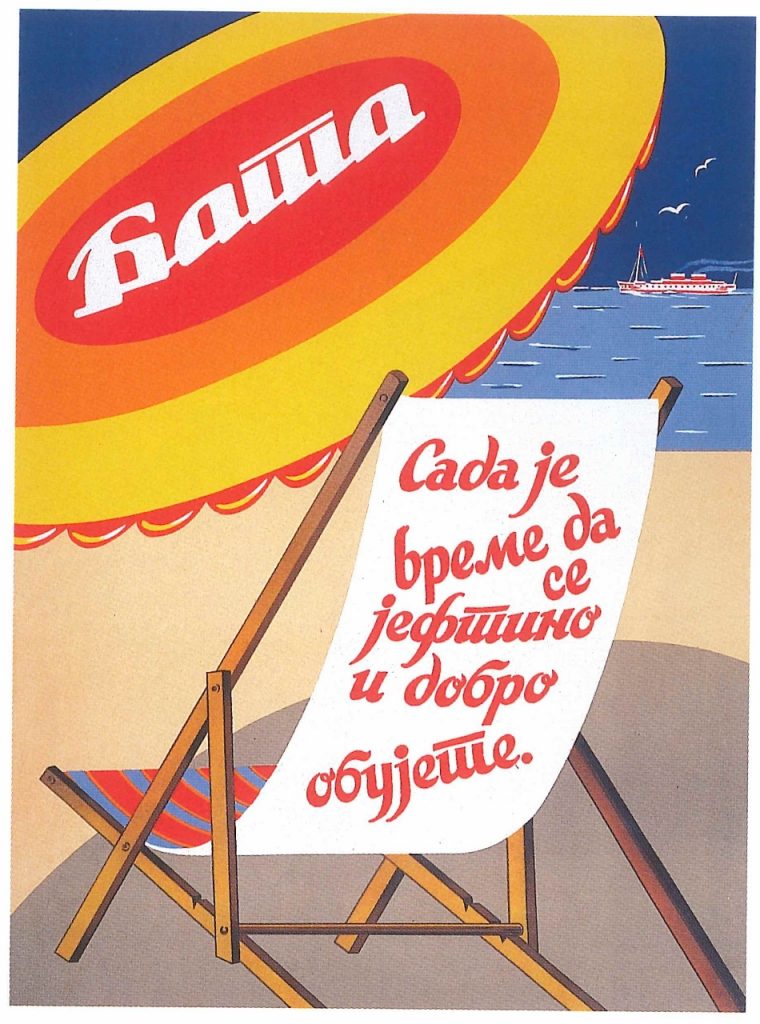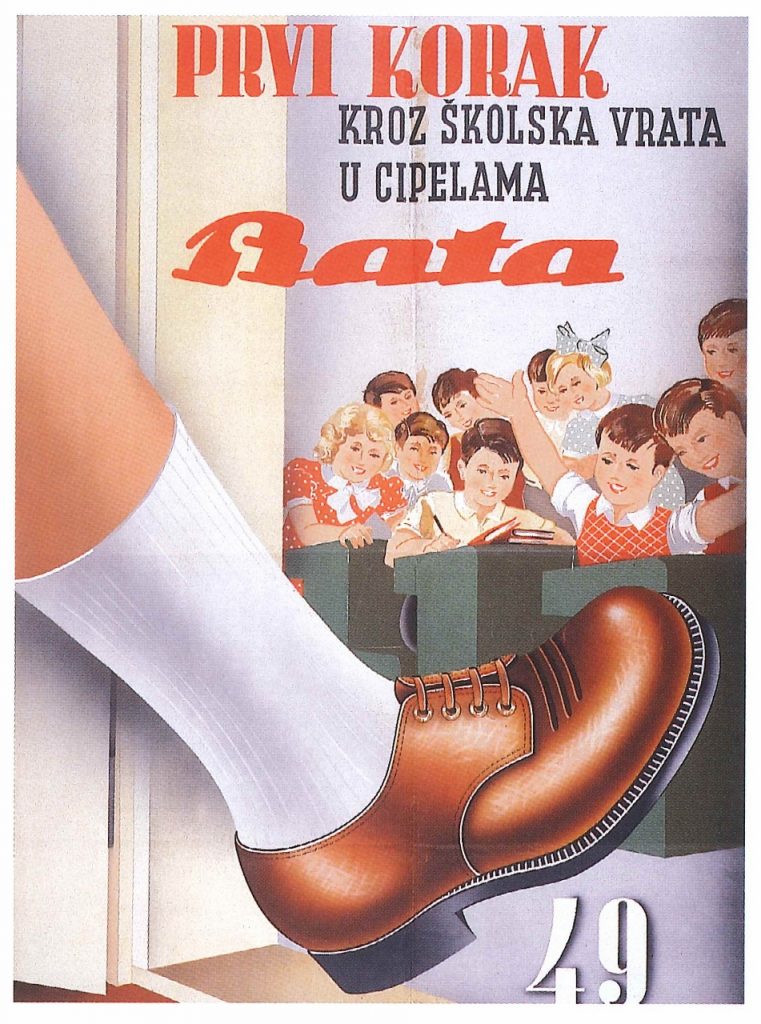(today Bosnia and Herzegovina, Montenegro, Croatia, Macedonia, Serbia)
In the interwar Yugoslavia (1918–1945), the Bata Company began its business when opening first shops in 1919, which was followed by starting of production in own factories; shoes were produced in 1931, and then the production of machines, textile started in 1937, tires in 1938, metallurgical production in 1939 and rubber goods in 1942.
- The first Bata shop was opened in Belgrade in 1919, with Toma Maksimović, future general director of Bata in Yugoslavia, as the store manager
- The firm Bata cipele i koža d.d. (Bata shoes and Leather, joint stock company), was founded on 15th of December 1920 in Zemun near Belgrade
- In 1921, a subsidiary firm was established in Zagreb from the Zemun headquarters
- In 1922 there were 5 Bata stores in country
- Until 1924, the company was run by a lawyer dr. Miša Semjan, who was replaced by Toma Maksimović, who belonged among the close associates of Tomáš Baťa. He later became the director of the factory in Borovo and the main representative of Bata company in Yugoslavia
- In October 1924 the headquarters of the company were transferred from Zemun to Zagreb by the resolution of Shareholders assembly from July 1924.
- In 1926, a branch office in Split and in a year later in Ljubljana were set up
- In 1926, 21 apprentices from Yugoslavia were trained in the company´s apprentice school in Zlín (Bata’s School of Labor)
- In the middle of the year 1930, the Bata retail network in the country counted around 20 stores. This number increased for additional 20 shops toward the end of that year and in May 1931, 70 more shops were added. At the end of 1932, Bata in Yugoslavia had in total 125 stores with 571 employees in them
- On August 23rd 1930, a change of the Company statutes made it possible to extend the business to factory production in the future; this change was registered in the Commercial Register in September 1930
- In December 1930, the company acquired large plots of land, the size of 500 acres at Borovo near Vukovar, on the bank of the Danube river
- In a memorandum to the Prime Minister Živkovic in 1931, Bata Company introduced its intention to build a new industrial and residential complex on the Danube near Vukovar. A brochure which depicted the future complex, with the factory buildings, hostels, sports grounds, cinema, shops, schools, hotels, hospitals, airports premises for residential areas was attached to this letter. The newspapers printed information about Bata intentions to build a factory and a town, consisting of: 28 factory objects, town hall, stores, 2 schools, 3 dormitories, 2 hotels, 2 public kitchens, cinema, workers´ house, social care building, aerodrome with 3 hangars, sports ground, 2 railway stations, 3 hospital buildings, residential buildings on 27th August 1931.
- In August 1931, the construction of a new factory in Borov started
- In the autumn of 1931, Bata produced 500 pairs of shoes daily in the temporary facilities in Vukovar
- In March of 1932, Bata launched the production in Apatin in the purchased shoe factory Elsa, which underwent extensive modernization, employing 150 workers; the production in Apatin ended in November 1932, when it was transferred to the factory in Borovo
- The construction site of the factory and company town in Borovo were carried out according to the project of the Zlín architect F. L. Gahura; the whole complex was similar to the Zlín model of the industrial and garden city; A. Vítek, another Bata architect in Zlín later also projected for Borovo; In February 1933, the factory in Borovo had 6 production buildings, a machine room, a power plant
- The Bata Company in Yugoslavia changed the official seat on 22nd October 1932 – and from Zagreb it officially moved to Borovo
- During December of 1932, the number of employees rose to 1200–1400 in the new factory in Borovo; the number of employees in the following year gradually increased – 1300 (in 1933); 1900 (1934); 2000 (1935); 3500 (1938); 3550 (1940)
- Shoe production also increased significantly in Borovo: in 1933 – 2,655,000 pairs; in 1935 – 4,105,000 pairs; in 1938 – 7,166,000, in 1940 – 4,842,000
- For its employees, the company in Borovo built family houses: in February 1933 the first 25 houses as the base of a residential colony were built; in 1936 it grew to 122 houses; the population of Borovo grew from 196 in 1933 to 1818 persons living in the residential area in 1936
- In the main stage of construction during the 1932–1938 period, the airport (1933), school (1933), sports stadium (1933), cinema, social house, etc. were gradually built.
- On 21. 9. 1933, company changed the name and it was registered under the name Bata, Jugoslovenske tvornice gume i obuće Borovo d. d. Bata (Bata,Yugoslav factory of rubber and shoes, joint stock company)
- In addition to the production of shoes, the company also expanded its retail network: in 1931 – there were 88 shops (with 197 employees); 1933 – 194 stores (422 employees); 1936 – 510 shops (938 employees); in 1938 – 515 stores; in 1940 – 565 stores. In March 1938, the first tire was made in the factory in Borovo, which was the beginning of the production of tires in Yugoslavia
- As a result of the war events in 1941–1945, the name of the company was changed; since 21st June 1941 it was “Bata, Hrvatske tvornice gume i obuće d. d.” (Bata, Croatian factory of rubber and shoes, joint stock company)
- During the war years 1941–1945 the production of shoes in Borovo fluctuated and gradually declined: in 1941 – 1,083,000 pairs, in 1942 – 2,198,000, in 1943 – 1,827,000 pairs, 1944 – 1,236,000 pairs; as did the number of employees: 1941 – 2800, 1942 – 2500, 1943 – 2300, 1944 – 1500
- After the liberation of Yugoslavia, the name of the company was restored in April 1945 – “Bata, Jugoslovenske tvornice gume i obuće d. d”
- From 24th April 1945, all Bata Yugoslav companies were under the temporary administration of the Ministry of Industry; a member of the Communist party was appointed to the factory management in Borovo on 15th September 1945
- In December 1946, the property of Bata in Yugoslavia – a factory in Borovo and other enterprises, including 342 stores, were nationalized; the nationalized enterprise, on 31st December 1946, was renamed Kombinat – Borovo (Jugoslovenski kombinat gume i obuće)
- In 1937, Bata bought about 2000 hectares of land in the village of Hamzali and surrounding villages near Strumica (Macedonia) with the intention of growing technical crops and obtaining raw materials; on farm which was named “Poljoprivredno dobro Hamzalija” (Hamzali Agricultural Farm) rational methods of agriculture were introduced. In 1941, after occupation of Yugoslavia, this part of the country was taken over by Bulgaria; the Hamzali holdings continued to be part of the Borovo property, but it was operated by the sister firm Kotva Bulgaria; during war years the Hamzali economy was oriented towards the local food production
- On 22nd February1937, Baťa launched a business at the Stolin factory in Vukovar, which was transformed into “Stolin d. d. Vukovar” (Stolin, Vukovar), and manufactured textile in Vukovar and Gredica near Brčko in Bosnia; operation in Gredica was completed at the end of September 1943 and production was transferred to Borovo
- On 10th May 1939, Bata founded the company “Majstor a. d. Beograd” for engineering production; the management of the company was based in Belgrade; the production facilities included the factory in Borovo, and the newly purchased iron–ore foundry in Bešlinac (near Novi Grad, Bosnia). In Poljavnica near Bešlinac, 120 hectares of land were purchased and projects were being prepared to build a new large engineering factory, but the war events prevented the intention. After the occupation of Yugoslavia (April 1941), the company was transformed; on 19th September 1941, the headquarters of the company were transferred to Borovo – “Majstor d.d. Borovo”, which continued the operations – in Bešlinac the production was stopped in 1942, but in Borovo it continued during the war years
- On 10th May 1939, Bata founded the company Nebojša a Beograd (Nebojša, a. s., Belgrade) for the intended rubber production, including gas masks, on the basis of a license obtained on 1st May 1939 from Ministry of Trade and Industry. This company planned to found a factory in Grabovica near Valjevo, but the works, which were launched in 1940 on the purchased site, ended with the outbreak of war; production activities were transferred to Belgrade – manufacturing and sale of gas masks; in 1942, a license for entrepreneurship in the leather industry was added. In Belgrade, the company ran production and storage facilities until 1945, and another sister company Celotvor rented a workshop in factory area in 1943
- On 10th May 1939, the Bata company founded (registered on 16 June 1939) the firm “Celofan a. d. Beograd”, which was soon renamed “Celotvor a. d. Beograd”
- The company manufactured wooden soles and heels in a workshop in Belgrade that was rented from Nebojsa – the operation started in 1943, when 90,000 pairs produced, 189,000 pairs were produced in 1944. The original production program included processing of wood for tannin, cellophane and artificial fibers, and the construction of a new factory in Poljavnice (Bosnia) was underway, but war events prevented realization of this plan
- In the summer of 1939, Bata acquired the objects of the town tanneries in Belgrade, which were later used for various purposes
- On 25th July1941, the firm Bata d.d. Beograd started to operate; it evolved from the prewar Bata subsidiary company Tomaks a.d. Bata Beograd focused on trading with all kinds of leather and footwear in Serbia and took over 180 Bata stores in Belgrade after the occupation and division of Yugoslavia in 1941
- Kotva d. Zagreb (Kotva, as, Zagreb) was established by the decision of the shareholders assembly on 24th December 1941 as an import and export company and was still active in 1945
- After acquiring of the company Narodno blagostanje a d. this firm was renamed to Kotva a. d. Beograd (Kotva, a., Belgrade) on 4th March 1944. The company was still active in 1946 when the entire property of Bata Company in Yugoslavia was seized by the Yugoslav government
- Bata published the following periodicals in Borovo: Borovo 1932–1941; Novo Borovo 1941–1944; Prodavaoc (1932)–1938
Sources:
- Kemal Hrelja – Martin Kaminski, Borovo, Jugoslovenski kombinat gume i obuće, Slavonski Brod 1971.
- Hugo von Haan, Die Arbeitsbedingungen in der rationalisierten schuhfabrik Baťa in Borovo, Jugoslawien, Genf 1938.
- Martin Jemelka – Ondřej Ševeček, Tovární města Baťova koncernu, Praha 2016, ISBN 978-80-200-2635-4.
- Martin Marek, Bouřlivá léta: Baťovské podnikatelské aktivity v širší střední Evropě za druhé světové války, In: Slovanský přehled – Slovanské historické studie, 3/2014, s. 629-687. ISSN 0037-6922.
- David Kolumber, Spory o Baťův odkaz, Ostrava 2016, ISBN 978-80-7418-252-5
- Moravský zemský archiv v Brně – Státní okresní archiv Zlín, Česko
- Arhiv Jugoslavije, Beograd, Srbsko
- Državni Arhiv u Vukovaru – Arhivski sabirni centar u Vinkovcima, Chorvatsko
- Hrvatski Državni Arhiv, Zagreb, Chorvatsko



